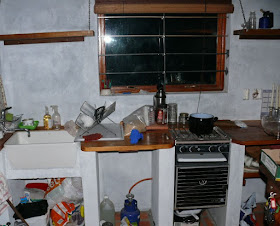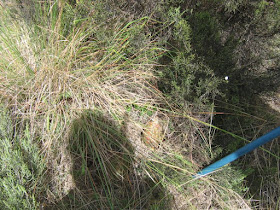To see what I am talking about - here is a photo of it - actually here is a photo of three loaves from one recipe.
 |
| L - R : BBQ grill, normal loaf pan, cast iron loaf pan |
I have been trying various recipes - but I have been trying one loaf / day at a time. Today I made a recipe that makes three loaves - so I thought, why not try and cook them in different containers.
Which I did.
One of the loaves I cooked on our BBQ grill, in a normal loaf pan. 30 minutes later - cooked and yummy looking.
My other two loaves I cooked in the solar oven.
Number 2 (on the left of the picture) was cooked in a normal loaf pan with another pan inverted on top of it. Number 3 was cooked in my cast iron loaf pan, with the lid on for the first 20 minutes - then I though about it and quickly removed the lid and loosely covered it with a piece of black silicone baking sheet. Judging by the BBQ grill cooked loaf it would need space to rise - hindsight showed the lid would certainly have restricted it!
 |
| A stitch in time, saves nine - jam cooking and jars / lids sterilizing simultaneously |
Naturally, RMan could barely wait the 40 minutes after the first loaf was finished cooking to have a slice - which he did, dolloping home made solar preserved plum jam!
 |
| All that lovely juice gathered safely in the botttom of the roasting tray - it can't dry out or evapourate because the heat isn't coming from the bottom like a normal oven :-) |
And, yesterday I cooked a whole chicken - but this time instead of just placing it inside the pot to cook, I lifted it off the base with a roasting grid, and turned the chicken upside down - that way the juices would baste the breasts as they dripped past. Delicious.
Tonight - chicken breasts wrapped in bacon - stuffed with solar dried tomatoes from the garden. With solar baked potatoes. And a fresh garden salad.
Anyway - you decide - which loaf would you like to eat?
 |
| If you click on the photo you'll see the texture of the bread better. |
 |
| I'm obviously as bad as RMan - I couldn't wait until I was finished taking photo's to have a taste too :-) |
Is there no one out there who would like me to try and convert their favourite recipe to a solar oven one?













































